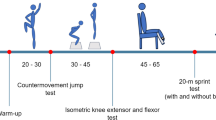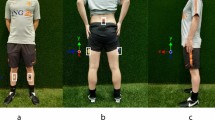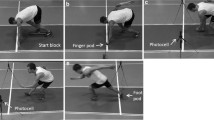Abstract
This paper proposes a 2D functional evaluation tool for estimating subject-specific body segment parameters, which uses a simple motor task (repeated sit-to-stand, rSTS), recorded with one single-axis accelerometer (SAA) per segment and a force plate (FP). After this preliminary estimation, the accelerometer alone is used to make quasi-real-time predictions of ground reaction force (anterior/posterior, F X , and vertical, F Z , components), center of pressure (CoP) and center of mass (CoM), during rSTS and postural oscillation in the sagittal plane. These predicted dynamic variables, as well as those obtained using anthropometric parameters derived from De Leva, were compared to actual FP outputs in terms of root mean-squared errors (RMSEs). Using De Leva’s parameters in place of those estimated, RMSEs increase from 12 to 21 N (F X ), from 21 to 24 N (F Z ), and from 21.1 to 55.6 mm (CoP) in rSTS; similarly, RMSEs increase from 3.1 to 3.3 N (F X ) and from 5.5 to 6.6 mm (CoP) in oscillatory trials. A telescopic inverted pendulum model was adopted to analyze the balance control in rSTS using only predicted CoP and CoM. Results suggest that one SAA per segment is sufficient to predict the dynamics of a biomechanical model of any degrees of freedom.







Similar content being viewed by others
Abbreviations
- CoP:
-
Center of pressure
- CoM:
-
Center of mass
- GRF:
-
Ground reaction force
- FP:
-
Force plate
- SP:
-
Stereo-photogrammetry
- SAA:
-
Single-axis accelerometer
- BMI:
-
Body mass index
- rSTS:
-
Repeated sit-to-stand
- AP:
-
Anterior/posterior
- HAT:
-
Head–arms–trunk
- ML:
-
Medium-lateral
- ICC3,1 :
-
Intra-class correlation coefficient
- RMSE:
-
Root mean-squared error
- CV:
-
Coefficient of variation
- TIP:
-
Telescopic inverted pendulum
- P 1 :
-
Vertical projection of the first sample of the predicted ΔCoP X on the seat surface
- P 2 :
-
Last sample of the predicted ΔCoP X under the feet
- LA:
-
Linear actuator
- SA:
-
Sagittal rotational actuator
- N :
-
Number of degrees of freedom of the model
- n :
-
Total number of samples of the signals
- \( i = 1, \ldots ,N \) :
-
Segmental index
- \( k = 1, \ldots ,n \) :
-
Temporal index
- F X, F Z \( \left[ {1 \times n} \right] \) :
-
AP and vertical components of the GRF (N)
- M Y \( \left[ {1 \times n} \right] \) :
-
ML component of the moment (Nm)
- ΔCoP X \( \left[ {1 \times n} \right] \) :
-
Displacement of the CoP in the AP direction with respect to the equilibrium position (m)
- ΔCoM X \( \left[ {1 \times n} \right] \) :
-
Displacement of the CoM in the AP direction with respect to the equilibrium position (m)
- ΔCoP Z \( \left[ {1 \times n} \right] \) :
-
Displacement of the CoM in the vertical direction with respect to the equilibrium position (m)
- ΔM Y \( \left[ {1 \times n} \right] \) :
-
ML component of the moment with respect to the equilibrium position (Nm)
- F X,FP, F Z,FP, M Y,FP :
-
\( \left[ {1 \times n} \right] \) FP outputs (N, N, Nm)
- \( {\text{CoP}}_{X}^{0} \) :
-
Distance between the origin of the FP’s reference system and the equilibrium position (m)
- \( M_{Y}^{0} \) :
-
ML component of the moment at the equilibrium position (Nm)
- \( {\mathbf{{\theta}}} ,{\dot{\mathbf{\theta }}}, {\ddot{\mathbf{\theta}}} \) \( \left[ {N \times n} \right] \) :
-
Angular deviation from vertical position (rad), angular velocity (rad/s), and angular acceleration (rad/s2)
- a \( \left[ {N \times n} \right] \) :
-
SAAs outputs (m/s2)
- \( {\mathbf{S}}_{{\mathbf{\theta}}} {\mathbf{, C}}_{{\mathbf{\theta,}}} {\ddot{{\mathbf{S}}}}_{{\mathbf{\theta,}}} {\ddot{{\mathbf{C}}}}_{{\mathbf{\theta,}}} {\mathbf{A}}_{{{\mathbf{IS}}}} \) \( \left[ {N \times n} \right] \) :
-
Sine, cosine, sine, and cosine second derivative, inter-segmental matrix related to \( {\mathbf{\theta}} ,{\dot{\mathbf{\theta }}}, {\ddot{\mathbf{\theta }}} \)
- \( {\tilde{\mathbf{D}}}, {\tilde{\mathbf{J}}} \) \( \left[ {N \times 1} \right] \) :
-
Anthropometric parameter vectors
- \( {\tilde{\mathbf{D}}}_{\text{De Leva}} ,{\tilde{\mathbf{J}}}_{\text{De Leva}} \) \( \left[ {N \times 1} \right] \) :
-
Anthropometric parameter vectors derived from De Leva’s tables
- g:
-
Gravity acceleration (m/s2)
- M:
-
Measured subject total body mass (kg)
- \( h_{i} ,m_{i} ,l_{i} ,d_{i} ,J_{i} ,H_{i} ,V_{i} ,T_{i} \) :
-
Distance of the SAA from the distal joint (m), segment mass (kg), segment length (m), distance of the CoM from the distal joint (m), moment of inertia (kg m2), horizontal force (N), vertical force (N), and net joint moment (Nm) of the ith segment
- \( m_{0} ,l_{0} ,\delta \) :
-
Estimated feet mass (kg), height of malleolus (m) and AP location of the feet CoM with respect to the malleolus (m)
- h c :
-
Height of the chair (m)
- \( N_{\text{W}} ,T_{\text{W}} \) :
-
Number of samples and duration (s) of the sliding time window
- \( {\varvec{\theta}}_{{\mathbf{W}}} \) \( \left[ {1 \times N_{\text{W}} } \right] \) :
-
Angular deviation from vertical position in the sliding time window (rad)
- \( {\mathbf{a}}_{{\mathbf{W}}} \) \( \left[ {1 \times \left( {N_{\text{W}} + 1} \right)} \right] \) :
-
SAA output in the sliding time window (m/s2)
References
Bagalà F, Fuschillo VL, Chiari L, Cappello A (2011) Calibrated 2D angular kinematics by single-axis accelerometers: from inverted pendulum model to N-link chain. IEEE Sens J 12(3):479–486
Buatois S, Miljkovic D, Manckoundia P, Gueguen R, Miget P, Vancon G, Perrin P, Benetos A (2008) Five times sit-to-stand test is a predictor of recurrent falls in healthy community-living subjects aged 65 and older. J Am Geriatr Soc 56(8):1575–1577
Caron O, Faure B, Breniére Y (1997) Estimating the center of gravity of the body on the basis of the center of pressure in standing posture. J Biomech 30:1169–1171
Chandler J, Duncan P, Kochersberger G, Studenski S (1998) Is lower extremity strength gain associated with improvement in physical performance and disability in frail, community-dwelling elders? Arch Phys Med Rehabil 79:24–30
Chandler RF, Clauser CE, McConville JT, Reynolds HM, Young JW (1975) Investigation of inertia properties of the human body. AMRL Technical Report: 74–137. Wright-Patterson Air Force Base, OH
Chen SC, Hsieh HJ, Lu TW, Tseng CH (2011) A method for estimating subject-specific body segment inertial parameters in human movement analysis. Gait Posture 33(4):695–700
Cheng CK, Chen HH, Chen CS, Chen CL, Chen CY (2000) Segment inertial properties of Chinese adults determined from magnetic resonance imaging. Clin Biomech 15:559–566
Chiari L (2011) Wearable systems with minimal set-up for monitoring and training of balance and mobility. In: Proceedings of the 33rd annual international conference of IEEE engineering in medicine and biology society, Boston, pp 5828–5832
Csuka M, McCarty D (1985) Simple method for measurement of lower-extremity muscle strength. Am J Med 78:77–81
De Leva P (1996) Adjustments to Zatsiorsky–Seluyanov’s segment inertial parameters. J Biomech 29(9):1223–1230
Dempster WT (1955) Space requirements for the seated operator. WADC Technical Report: 55–219. Wright-Patterson Air Force Base, OH
Donhey EP, Fan CW, Foran T, Green BR, Cunningham C, Kenny A (2011) An instrumented sit-to-stand test used to examine differences between older fallers and non-fallers. In: Proceedings of the 33rd annual international conference of IEEE engineering in medicine and biology society, Boston, pp 3063–3066
Draper NR, Smith H (1998) Applied regression analysis (Wiley series in probability and statistics), 3rd edn. Wiley, New York
Dunkan RP, Leddy AL, Earhart GM (2011) Five times sit-to-stand test performance in Parkinson’s disease. Arch Phys Med Rehabil 92:1431–1436
Durkin JL, Dowling JJ (2003) Analysis of body segment parameter differences between four human populations and the estimation errors of four popular mathematical models. J Biomech Eng 125:515–522
Fujimoto M, Chou LS (2012) Dynamic balance control during sit-to-stand movement: an examination with the center of mass acceleration. J Biomech 45:543–548
Hanavan EP (1964) A mathematical model of the human body. AMRL Technical Report: 64–102. Wright-Patterson Air Force Base, OH
Hasan SS, Robin DW, Szurkus DC, Ashmead DH, Peterson SW, Shiavi RG (1996) Simultaneous measurement of body center of pressure and center of gravity during upright stance. Part I: methods. Gait Posture 4:1–10
Hatze H (1980) A mathematical model for the computational determination of parameter values of anthropomorphic segments. J Biomech 13:833–843
Horak FB (1997) Clinical assessment of balance disorders. Gait Posture 6(1):76–84
Iqbal K (2011) Mechanisms and models of postural stability and control. In: Proceedings of the 33rd annual international conference of IEEE engineering in medicine and biology society, Boston, pp 7837–7840
Jensen RK (1978) Estimation of biomechanical properties of three body types using a photogrammetry method. J Biomech 11:349–358
Kaya BK, Krebs D, Riley PO (1998) Dynamic stability in elders: momentum control in locomotor ADL. J Gerontol A Biol Sci Med Sci 53 A(2):M126–M134
Lecours J, Nadeau S, Gravel D, Teixera-Salmela L (2008) Interactions between foot placement, trunk frontal position, weight-bearing and knee moment asymmetry at seat-off during rising from a chair in healthy controls and persons with hemiparesis. J Rehabil Med 40:200–207
Lenzi D, Cappello A, Chiari L (2003) Influence of body segment parameters and modeling assumptions on the estimate of center of mass trajectory. J Biomech 36:1335–1341
Lord SR, Murray SM, Chapman K, Munro B, Tiedemann A (2002) Sit-to-stand performance depends on sensation, speed, balance and psychological status in addition to strength in older people. J Gerontol A Biol Sci Med Sci 57:M539–M543
Mazzà C, Stanhope SJ, Taviani A, Cappozzo A (2006) Biomechanical modeling of sit-to-stand to upright posture for mobility assessment of persons witch chronic stroke. Arch Phys Med Rehabil 91(2):288–297
Pai YC, Naughton BJ, Chang RW, Rogers MW (1994) Control of body center of mass momentum during sit-to-stand among young and elderly adults. Gait Posture 2:109–116
Pai YC, Patton J (1997) Center of mass velocity–position predictions for balance control. J Biomech 30(4):347–354
Papa E, Cappozzo A (1999) A telescopic inverted-pendulum model of the musculo-skeletal system and its use for the analysis of the sit-to-stand motor task. J Biomech 32:1205–1212
Prieto TE, Myklebust JB, Hoffman RG, Lovett EG, Myklebust BM (1996) Measures of postural steadiness: differences between healthy young and elderly adults. IEEE Trans Bio Med Eng 43:956–966
Riemer R, Hsiao-Wecksler ET (2009) Improving net joint torque calculations through a two-step optimization method for estimating body segment parameters. J Biomech Eng 131(1):011007
Roebroeck M, Doorenbosch C, Harlaar J, Jacobs R, Lankhorst G (1994) Biomechanics and muscular activity during sit-to-stand transfer. Clin Biomech 9(235):244
Sandoz B, Laporte S, Skalli W, Mitton D (2010) Subject-specific body segment parameters’ estimation using biplanar X-rays: a feasibility study. Comput Methods Biomech Biomed Eng 13(6):649–654
Sheets AL, Corazza S, Andriacchi TP (2010) An automated image-based method of 3D subject-specific body segment parameter estimation for kinetic analysis of rapid movements. J Biomech Eng 132(1) (article 011004)
Shimba T (1984) An estimation of center of gravity from force platform data. J Biomech 7:53–60
Vaughan CL, Andrews JG, Hay JG (1982) Selection of body segment parameters by optimization methods. J Biomech Eng 104(1):38–44
Vette AH, Yoshida T, Thrasher TA, Masani K, Popovic MR (2011) A complete, non-lumped, and verifiable set of upper body segment parameters for three-dimensional dynamic modeling. Med Eng Phys 33:70–79
Wicke J, Dumas GA (2008) Estimating segment inertial parameters using fan-beam DEXA. J Appl Biomech 24:180–184
Winter DA (1995) Human balance and posture control during standing and walking. Gait Posture 3:193–214
Winter DA, Patla AE, Prince F, Ishac M, Gielo-Perczak K (1998) Stiffness control of balance in quiet standing. J Neurophysiol 80(3):1211–1221
Yeadon MR (1990) The simulation of aerial movement-II. A mathematical inertia model of the human body. J Biomech 23(1):67–74
Zatsiorsky VM, Seluyanov VN, Chugunova LG (1990) Methods of determining mass-inertial characteristics of human body segments. In: Chernyi GG, Regirer SA (eds) Contemporary problems of biomechanics. CRC Press, Boston, pp 272–291
Zatsiorsky VM, King DL (1998) An algorithm for determining gravity line location from posturographic recordings. J Biomech 31:161–164
Zijlstra W, Bisseling RW, Schlumbohm S, Baldus H (2010) A body-fixed-sensor-based analysis of power during sit-to-stand movements. Gait Posture 31(272):278
Acknowledgments
The authors would like to thank Kristina Mayberry for the linguistic revision of the manuscript.
Author information
Authors and Affiliations
Corresponding author
Rights and permissions
About this article
Cite this article
Fuschillo, V.L., Bagalà, F., Chiari, L. et al. Accelerometry-based prediction of movement dynamics for balance monitoring. Med Biol Eng Comput 50, 925–936 (2012). https://doi.org/10.1007/s11517-012-0940-6
Received:
Accepted:
Published:
Issue Date:
DOI: https://doi.org/10.1007/s11517-012-0940-6




